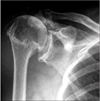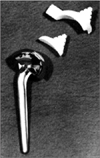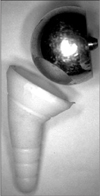Abstract
The purpose of this article was to explore current concepts of arthroplasty as a treatment for massive rotator cuff tears. Pubmed was searched using the words 'massive rotator cuff tears' and 'arthroplasty' for suitable articles, which were then reviewed and investigated with respect to history, indications, clinical outcomes, and treatment algorithms of arthroplasty in patients of massive rotator cuff tear. Arthroplasty can be considered a primary surgical treatment for patients with irreparable massive rotator cuff tears and hemiarthroplasty may be the treatment of choice in younger patients with an intact coracoacromial arch and no pseudoparalysis. Reverse total shoulder arthroplasty is the best surgical treatment for pain relief and the restoration of active forward flexion in elderly patients with cuff tear arthropathy and pseudoparalysis. Proper selection of arthroplasty can provide pain relief and functional improvement in patients with massive rotator cuff tears. However, complication rates remain high, and emphasize the importance of appropriate patient selection and careful operative technique.
Figures and Tables
 | Figure 1True anteroposterior radiograph of a shoulder with cuff tear arthropathy demonstrating glenohumeral arthritis, superior glenoid wear, proximal humeral migration, and acetabularization of the acromion. |
 | Figure 2(A) Mechanical and (B) nutritional factors have been hypothesized to contribute to joint destruction in rotator cuff tear arthropathy.4)
|
 | Figure 3Assembled constrained prosthesis: 1, metal glenoid cup; 2, tightened metal locking ring; 3, Series-I1 humeral head; 4, position of eccentric screw holes on the back plate; 5, central metal stem.16)
|
 | Figure 4Semiconstrained Dana shoulder prosthesis.17)
|
 | Figure 5Hemiarthroplasty with a laterally extended cuff tear arthropathy (CTA) head. (A) CTA prosthesis, (B) diagram of installed prosthesis.22)
|
 | Figure 6Grammont's original reverse total shoulder arthroplasty.25)
|
 | Figure 7(A) Earlier reverse total shoulder prosthesis design, with a small glenosphere component and a lateralized center of rotation. (B) The modern design with a large glenosphere, a non-anatomic valgus angle of the humeral implant, and medial and distal positioning of the center of rotation.26)
|
 | Figure 8(A) Severe fatty infiltration of the infraspinatus and teres minor (B) loss of active external rotation of the right shoulder. |
 | Figure 9Plain radiograph (A) showing scapular notching at the lateral pillar of the inferior glenoid neck and a polyethylene insert (B) attrited by the scapular notching phenomenon. |
 | Figure 10A proposed treatment algorithm for the management of massive, irreparable rotator cuff tears. RTC, rotator cuff; GH, glenohumeral; RTSA, reverse total shoulder arthroplasty; CTA, cuff tear arthropathy.46)
|
References
1. Post M, Silver R, Singh M. Rotator cuff tear. Diagnosis and treatment. Clin Orthop Relat Res. 1983. 173:78–91.
2. Gerber C, Fuchs B, Hodler J. The results of repair of massive tears of the rotator cuff. J Bone Joint Surg Am. 2000. 82:505–515.

3. Neer CS 2nd, Craig EV, Fukuda H. Cuff-tear arthropathy. J Bone Joint Surg Am. 1983. 65:1232–1244.

4. Feeley BT, Gallo RA, Craig EV. Cuff tear arthropathy: current trends in diagnosis and surgical management. J Shoulder Elbow Surg. 2009. 18:484–494.

5. Zingg PO, Jost B, Sukthankar A, Buhler M, Pfirrmann CW, Gerber C. Clinical and structural outcomes of nonoperative management of massive rotator cuff tears. J Bone Joint Surg Am. 2007. 89:1928–1934.

6. Hersche O, Gerber C. Passive tension in the supraspinatus musculotendinous unit after long-standing rupture of its tendon: a preliminary report. J Shoulder Elbow Surg. 1998. 7:393–396.

7. Gladstone JN, Bishop JY, Lo IK, Flatow EL. Fatty infiltration and atrophy of the rotator cuff do not improve after rotator cuff repair and correlate with poor functional outcome. Am J Sports Med. 2007. 35:719–728.

8. Burkhart SS. Arthroscopic treatment of massive rotator cuff tears. Clinical results and biomechanical rationale. Clin Orthop Relat Res. 1991. 267:45–56.
9. Gartsman GM. Massive, irreparable tears of the rotator cuff. Results of operative debridement and subacromial decompression. J Bone Joint Surg Am. 1997. 79:715–721.

10. Gerber C, Maquieira G, Espinosa N. Latissimus dorsi transfer for the treatment of irreparable rotator cuff tears. J Bone Joint Surg Am. 2006. 88:113–120.

11. Kempf JF, Gleyze P, Bonnomet F, et al. A multicenter study of 210 rotator cuff tears treated by arthroscopic acromioplasty. Arthroscopy. 1999. 15:56–66.

12. Neer CS 2nd, Watson KC, Stanton FJ. Recent experience in total shoulder replacement. J Bone Joint Surg Am. 1982. 64:319–337.

13. Rockwood CA Jr, Williams GR Jr, Burkhead WZ Jr. Debridement of degenerative, irreparable lesions of the rotator cuff. J Bone Joint Surg Am. 1995. 77:857–866.
14. Sarris IK, Papadimitriou NG, Sotereanos DG. Bipolar hemiarthroplasty for chronic rotator cuff tear arthropathy. J Arthroplasty. 2003. 18:169–173.

15. Zuckerman JD, Scott AJ, Gallagher MA. Hemiarthroplasty for cuff tear arthropathy. J Shoulder Elbow Surg. 2000. 9:169–172.

16. Post M, Jablon M. Constrained total shoulder arthroplasty. Long-term follow-up observations. Clin Orthop Relat Res. 1983. 173:109–116.
17. Amstutz HC, Thomas BJ, Kabo JM, Jinnah RH, Dorey FJ. The Dana total shoulder arthroplasty. J Bone Joint Surg Am. 1988. 70:1174–1182.

18. Orr TE, Carter DR, Schurman DJ. Stress analyses of glenoid component designs. Clin Orthop Relat Res. 1988. 232:217–224.

19. Franklin JL, Barrett WP, Jackins SE, Matsen FA 3rd. Glenoid loosening in total shoulder arthroplasty. Association with rotator cuff deficiency. J Arthroplasty. 1988. 3:39–46.
20. Nwakama AC, Cofield RH, Kavanagh BF, Loehr JF. Semiconstrained total shoulder arthroplasty for glenohumeral arthritis and massive rotator cuff tearing. J Shoulder Elbow Surg. 2000. 9:302–307.

21. Goldberg SS, Bell JE, Kim HJ, Bak SF, Levine WN, Bigliani LU. Hemiarthroplasty for the rotator cuff-deficient shoulder. J Bone Joint Surg Am. 2008. 90:554–559.

22. Frankle MA. Rotator cuff deficiency of the shoulder. 2008. New York: Thieme Medical Publishers, Inc.;67–104.
23. Visotsky JL, Basamania C, Seebauer L, Rockwood CA, Jensen KL. Cuff tear arthropathy: pathogenesis, classification, and algorithm for treatment. J Bone Joint Surg Am. 2004. 86:Suppl 2. 35–40.
24. Sanchez-Sotelo J, Cofield RH, Rowland CM. Shoulder hemiarthroplasty for glenohumeral arthritis associated with severe rotator cuff deficiency. J Bone Joint Surg Am. 2001. 83:1814–1822.

25. Baulot E, Sirveaux F, Boileau P. Grammont's idea: the story of Paul Grammont's functional surgery concept and the development of the reverse principle. Clin Orthop Relat Res. 2011. 469:2425–2431.

26. Gartsman GM, Edwards TB. Shoulder arthroplasty. 2008. 1st ed. Philadelphia: Elsevier Saunders.
27. Sirveaux F, Favard L, Oudet D, Huquet D, Walch G, Molé D. Grammont inverted total shoulder arthroplasty in the treatment of glenohumeral osteoarthritis with massive rupture of the cuff. Results of a multicentre study of 80 shoulders. J Bone Joint Surg Br. 2004. 86:388–395.
28. Werner CM, Steinmann PA, Gilbart M, Gerber C. Treatment of painful pseudoparesis due to irreparable rotator cuff dysfunction with the Delta III reverse-ball-and-socket total shoulder prosthesis. J Bone Joint Surg Am. 2005. 87:1476–1486.

29. Cuff D, Pupello D, Virani N, Levy J, Frankle M. Reverse shoulder arthroplasty for the treatment of rotator cuff deficiency. J Bone Joint Surg Am. 2008. 90:1244–1251.

30. Boileau P, Watkinson D, Hatzidakis AM, Hovorka I. Neer Award 2005: the Grammont reverse shoulder prosthesis: results in cuff tear arthritis, fracture sequelae, and revision arthroplasty. J Shoulder Elbow Surg. 2006. 15:527–540.

31. Bufquin T, Hersan A, Hubert L, Massin P. Reverse shoulder arthroplasty for the treatment of three- and four-part fractures of the proximal humerus in the elderly: a prospective review of 43 cases with a short-term follow-up. J Bone Joint Surg Br. 2007. 89:516–520.
32. Wall B, Nové-Josserand L, O'Connor DP, Edwards TB, Walch G. Reverse total shoulder arthroplasty: a review of results according to etiology. J Bone Joint Surg Am. 2007. 89:1476–1485.
33. Young SW, Everts NM, Ball CM, Astley TM, Poon PC. The SMR reverse shoulder prosthesis in the treatment of cuff-deficient shoulder conditions. J Shoulder Elbow Surg. 2009. 18:622–626.

34. Frankle M, Levy JC, Pupello D, et al. The reverse shoulder prosthesis for glenohumeral arthritis associated with severe rotator cuff deficiency. A minimum two-year follow-up study of sixty patients surgical technique. J Bone Joint Surg Am. 2006. 88:Suppl 1 Pt 2. 178–190.
35. Favard L, Levigne C, Nerot C, Gerber C, De Wilde L, Mole D. Reverse prostheses in arthropathies with cuff tear: are survivorship and function maintained over time? Clin Orthop Relat Res. 2011. 469:2469–2475.

36. Boileau P, Gonzalez JF, Chuinard C, Bicknell R, Walch G. Reverse total shoulder arthroplasty after failed rotator cuff surgery. J Shoulder Elbow Surg. 2009. 18:600–606.

37. Mulieri P, Dunning P, Klein S, Pupello D, Frankle M. Reverse shoulder arthroplasty for the treatment of irreparable rotator cuff tear without glenohumeral arthritis. J Bone Joint Surg Am. 2010. 92:2544–2556.

38. Oh JH, Kim SH, Shin SH, et al. Outcome of rotator cuff repair in large-to-massive tear with pseudoparalysis: a comparative study with propensity score matching. Am J Sports Med. 2011. 39:1413–1420.
39. Boileau P, Chuinard C, Roussanne Y, Bicknell RT, Rochet N, Trojani C. Reverse shoulder arthroplasty combined with a modified latissimus dorsi and teres major tendon transfer for shoulder pseudoparalysis associated with dropping arm. Clin Orthop Relat Res. 2008. 466:584–593.

40. Zumstein MA, Pinedo M, Old J, Boileau P. Problems, complications, reoperations, and revisions in reverse total shoulder arthroplasty: a systematic review. J Shoulder Elbow Surg. 2011. 20:146–157.

41. Lévigne C, Boileau P, Favard L, et al. Scapular notching in reverse shoulder arthroplasty. J Shoulder Elbow Surg. 2008. 17:925–935.

42. Simovitch RW, Zumstein MA, Lohri E, Helmy N, Gerber C. Predictors of scapular notching in patients managed with the Delta III reverse total shoulder replacement. J Bone Joint Surg Am. 2007. 89:588–600.

43. Gutiérrez S, Greiwe RM, Frankle MA, Siegal S, Lee WE 3rd. Biomechanical comparison of component position and hardware failure in the reverse shoulder prosthesis. J Shoulder Elbow Surg. 2007. 16:S9–S12.

44. Nyffeler RW, Werner CM, Gerber C. Biomechanical relevance of glenoid component positioning in the reverse Delta III total shoulder prosthesis. J Shoulder Elbow Surg. 2005. 14:524–528.

45. Edwards TB, Williams MD, Labriola JE, Elkousy HA, Gartsman GM, O'Connor DP. Subscapularis insufficiency and the risk of shoulder dislocation after reverse shoulder arthroplasty. J Shoulder Elbow Surg. 2009. 18:892–896.

46. Nam D, Maak TG, Raphael BS, Kepler CK, Cross MB, Warren RF. Rotator cuff tear arthropathy: evaluation, diagnosis, and treatment: AAOS exhibit selection. J Bone Joint Surg Am. 2012. 94:e34.




 PDF
PDF ePub
ePub Citation
Citation Print
Print


 XML Download
XML Download